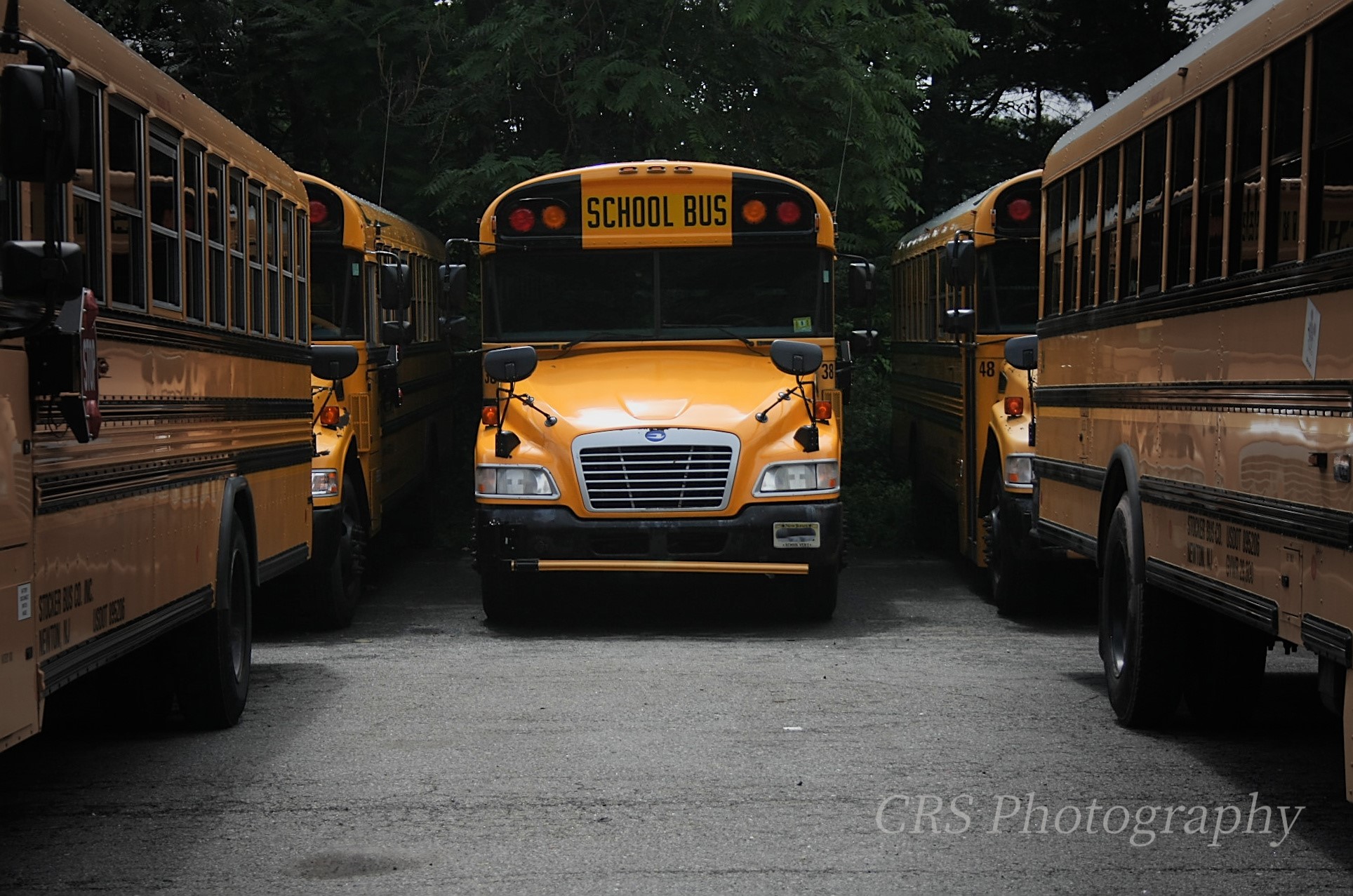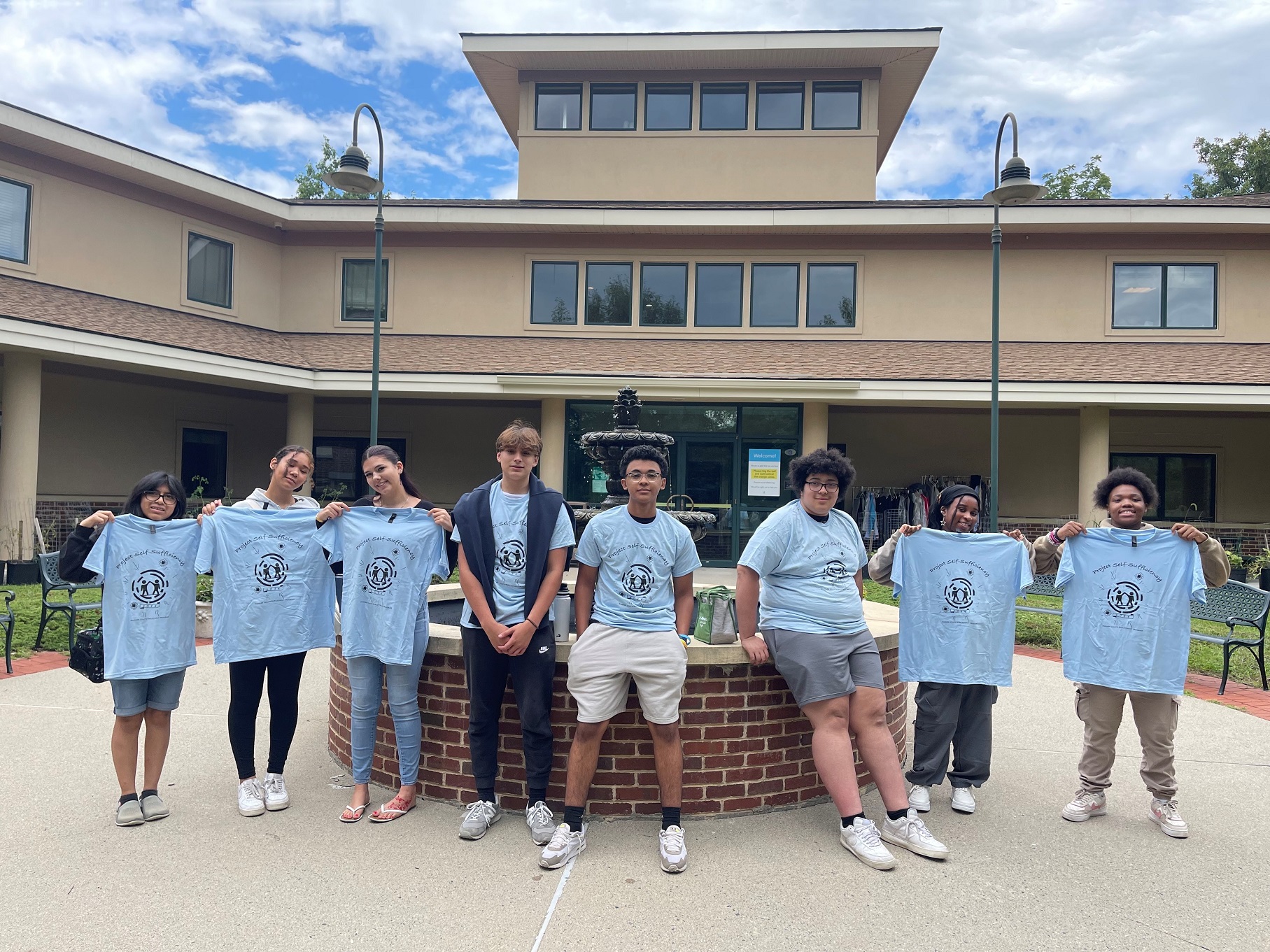Any time of year, but most especially around the 4th of July, is an ideal time to learn about the impact of the American Revolution on Sussex County. In an era that was pivotal to the birth of our nation, Sussex County, and players from it, played a part in history. Below is a town-by-town breakdown of American Revolutionary War sites within Sussex County to explore:
Andover Borough
Andover Furnace, Route 206 South near Lenape Road.
A special marker near the borough’s Main Street gives the location of where Andover Furnace had been. Founded in 1760 and named after Andover in England, English company Allen & Turner opened its doors, but was confiscated by the Continental Congress in 1778, to craft steel from pig iron in support of the Continental Army. The Borough of Andover additionally hung its own marker in 1964 for the Iron Master’s Mansion near Grist Mill Lane. In 2003, another marker was added by the County of Sussex for the Iron Works at Andover overall.
Fredon Township
Muckshaw Ponds Preserve, Route 206 and Fredon-Springdale Road.
Infamous loyalist and Sussex County Farmer James Moody known for raiding county homes and other locations on behalf of the British, took refuge here. He gained a reputation as “villain” from none other than General George Washington. Moody was apparently very familiar with this wooded area, which the Ridge and Valley Conservancy now oversees. Its 201 acres feature three immense sinkhole ponds with rare species. The public walking trail through the preserve starts at the Whittingham Wildlife Refuge parking area on Fredon-Springdale Road. Muckshaw Farm on the property is operated by the Foodshed Alliance’s Sustainable Agriculture Enterprise (SAgE).
Hamburg Borough
Hamburg Baptist Church Cemetery, 15 Route 23 North.
Five patriots are in their eternal rest in Hamburg at this cemetery. Private James Hamilton, who died in 1822, is featured on a prominent monument with the names of several of his family members. Hamilton was a carpenter who built the Lawrence Mansion, then known as the “Claremont,” in 1794. Born at sea on the way to the colonies, he began his carpenter career in Philadelphia, where he was taken captive by the British in 1777 as he served in the Revolution. As the story goes, he tied his clothes together and then escaped from their man-of-war but lost his garments as he swam back to the city. He returned to the boarding house where he lived, and when the owner found him in the room, he asked her for clothes and then instructed her to state she had never seen him. He averted the pursuing British, making his way to Orange County, New York, before Sussex County. There are four other privates here, two from the New Jersey Militia and two from New York’s, who received new headstones in 2012. James Edsall, who died in 1840, and Henry Simpson, who died in 1841, both served from New Jersey. Conrad Tinkey, who passed away in 1846, and Henry Windfield, who died in 1840, from New York, are also buried there.
Joseph Sharp’s Iron Works, Gingerbread Castle Road.
The iron works began operating in 1768, with it surrounded by the village then called Sharpsborough, but its owner Joseph Sharp Sr. left the business behind because of financial difficulties to return to Salem County in 1774, where he was originally from. Unlike the Andover Iron Works confiscated by the patriots, resident Stephen Ford, who took this Iron Works over, was a sympathizer who covertly manufactured cannonballs for the British Army. His father died in 1776, and Joseph Sharp, Jr. took ownership of the property following the Revolution, He built a stone grist mill here in 1808. That grist mill continued to serve Sussex County, including during the War of 1812.
Hampton Township
Unknown Soldier Monument, Cherry Lane.
After one leaves the bustling Route 206 traffic and passes Hampton Commons, a quieter portion of the neighborhood, which was a Revolutionary main road, has a small monument dedicated in memory to an unknown patriot. As George Washington and the Continental Army marched from Morristown to Newburgh, New York, this soldier died here along the way from exhaustion and was buried in that spot. The Chinkchewunska Chapter of the Daughters of the American Revolution placed the stone in his memory here in 1931, also then honoring all the other soldiers who fought in the American Revolution.
Hardyston Township
North Hardyston Cemetery, Route 94 and North Church Road.
Once the site of “North Church,” there are many of Sussex County’s first citizens in the cemetery, as well as six soldiers who fought for independence. One is Captain Charles Beardsley of the Orange County Militia, who died in 1803. Private Ashman Carpenter of the Morris County Militia is another who died in 1839. Private John Linn of the Sussex County Militia, who died in 1821, is also here. He later became a sergeant and U.S. Representative. Private James Scott of the Sussex County 2nd Regiment is the fourth, who died in 1828. Private Ebenezer Tuttle of the Morris County Militia, who died in 1834, is the fifth. Private Simon Wade of the Sussex County Militia, who died in 1817, is the final one. Isaac Cary, who was a financier for the war and died in 1791, is additionally here.
George Washington Continental Army Encampment, Route 94 and Beaver Run Road.
A monument stands to commemorate one of George Washington’s encampments at that site. He stayed here as he traveled from Newburgh, New York to Morristown. Newton resident Lieutenant John Kays was with him, and as the group was at Sparta Mountain, Washington realized his watch was missing. Kays was sent back to the encampment to retrieve it and did so successfully.
Town of Newton
Christ Episcopal Church/Thomas Anderson Home, 62 Main Street.
Newton was already the county seat in 1761 when Christ Episcopal Church organized its first vestry in 1769. Though its 1662 prayer book had prayers for the King of England, one of the church’s first members was Assistant Deputy Quartermaster and local lawyer Thomas Anderson. George Washington was known to have stayed in Newton and dined at Anderson’s home, which was then located in the square. Anderson’s wife Letitia was part of the Sussex County Ladies’ Aid Committee supporting the Continental Army. Anderson later became the county’s first surrogate and an acting county clerk. His home was physically moved to its current location across from the Newton Post Office in 1896 and is part of the Christ Episcopal Church complex.
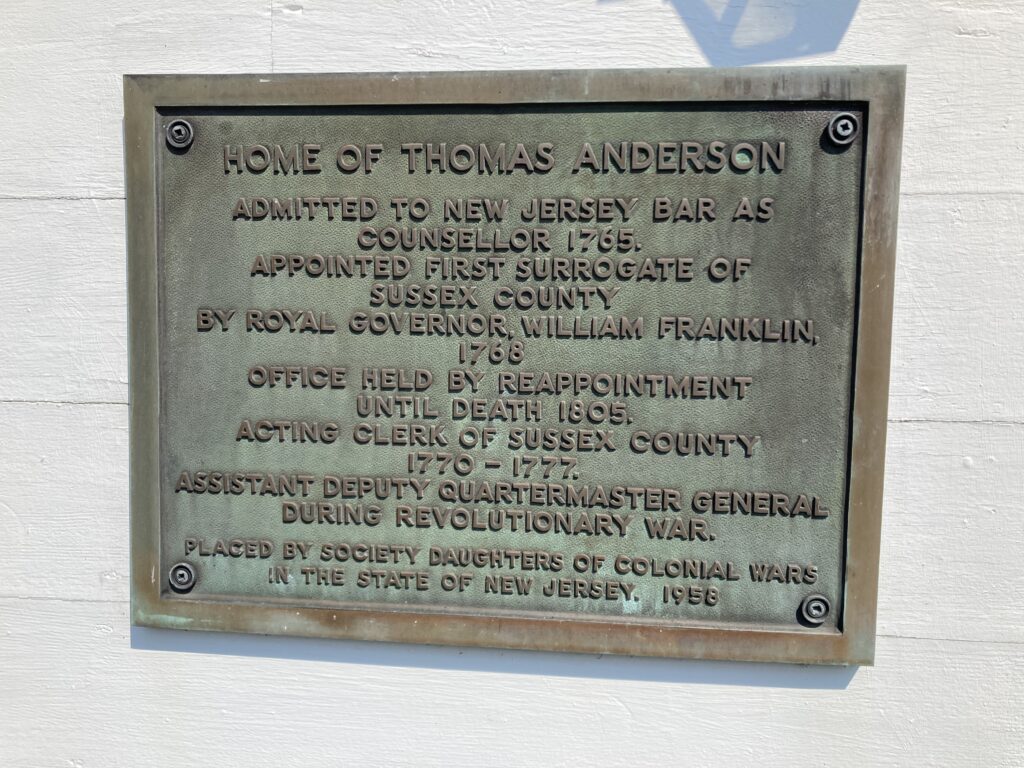
Old Newton Burial Ground, Main Street (behind the Sussex County Community College McGuire Technical Education Center).
The Andersons and many other patriots, like Lieutenant John Kays, rest eternally in the Old Newton Burial Ground, its oldest portion dedicated in 1762. This is where many of the county’s first citizens overall are also buried.
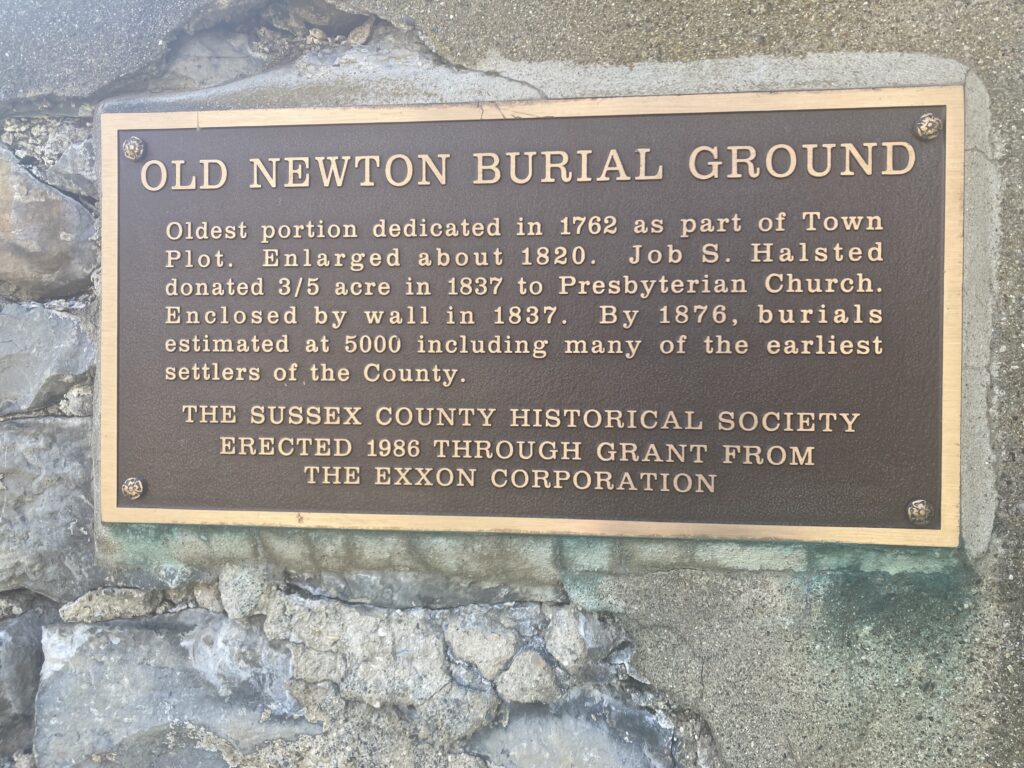
Sussex County Historic Courthouse, High Street.
Though the original courthouse burned down in 1847, the current courthouse is on the site of the original that opened in 1765. George Washington stopped there in November 1780 and July 1782. Now on the National Register of Historic Places, this was another spot relevant to James Moody, who led a raid in May 1780 to free eight imprisoned loyalists. He orchestrated a stunt, stating he was delivering another loyalist, but the jailor refused to open the door. Moody, with another band of loyalists from the city, identified himself and threatened the jailor before they gave an Indian war whoop. The residents panicked, and Moody’s group freed the prisoners.
Moody’s Raid Marker, Dennis Library, 101 Main Street.
Moody’s many activities throughout the county earned him another marker, this time on the fence in front of the Dennis Library. The marker, from 1958, also commemorates Thomas Anderson storing Revolutionary War supplies in town, George Washington marching through in 1779, and General Horatio Gates’ detachment stationed in town.
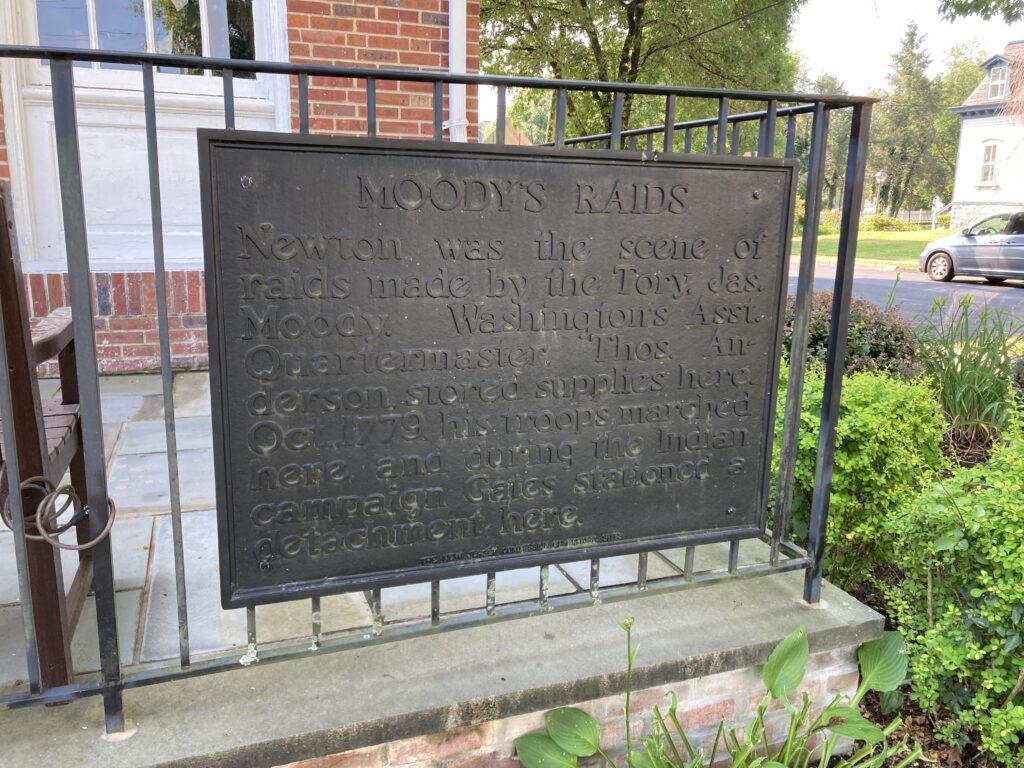
Tree in Memory of George Washington, Sussex County Historical Society, 82 Main Street.
A tree was dedicated in memory of George Washington in 1932 by the Daughters of the American Revolution, Chinkchewunska Chapter, with a plaque next to the Sussex County Historical Society building adjacent to Church Street. There is a second plaque from when the tree was rededicated in 2007.
Sandyston Township
Mettler Cemetery, Old Mine Road.
There are three cemeteries in Sandyston where Revolutionary War patriots are buried. Two soldiers from the Morris Militia are here. One is drummer boy and later Private Even Bevans, who died in 1849, and the second, Private Jacob Emery, who died in 1824.
The Ancient Minisink/Westbrook Family Burial Ground, Old Mine Road.
When the Battle of Conneshaugh erupted across the Delaware in Raymondskill, Pennsylvania, involving Sussex County and Pennsylvania militia members, 14 unknown soldiers died. They were carried back to this burial ground, founded in 1731. They initially had cedar crosses as grave markers, but all now share one monument. The burial ground has one modern headstone for Captain Peter Westbrook, who also died that day.
Hainesville Cemetery, Cemetery Road.
More Revolutionary War soldiers, who were Sandyston residents, are buried at this cemetery. Benjamin DePue (Depew) served in the New York Regiment and died in 1940. Private Timothy Shay died in 1840 and served in the Continental Line. Each donated land in 1812 for the cemetery.
Sparta Township
Moody’s Raid Marker, VFW Building, 66 Main Street.
Sparta was another Sussex County place subject to Moody’s raids. In 1781 (by some accounts 1779), Moody and his followers specifically targeted and plundered the home of respected lawyer, judge, and founder of the township and First Presbyterian Church of Sparta, Robert Ogden. After threatening him, Moody told Ogden to wait before alerting anyone that they had been there. When Ogden was Speaker of the New Jersey Assembly and delegate to the Stamp Act Congress and disagreed with not circulating the resolutions among the colonial assemblies before they were submitted to King George III, loyalists like Moody frowned upon his actions for not signing off, burning him in effigy. Ogden resigned his seat on the Assembly. Ogden moved to Sparta and built his home there in 1778, as well as an iron forge. The Presbyterian Church he pastored was established in 1786. His eternal resting place is next to the church within the Sparta Cemetery.
Walpack Township
Van Campen Inn, Old Mine Road.
Though the Van Campen Inn was built in 1750, it holds numerous stories about the American Revolution. Now part of the Delaware Water Gap National Recreation Area, owner Isaac Van Campen served on New Jersey’s Provincial Congress as a delegate in 1776.
Colonel John Rosenkrans Monument, Old Mine Road.
Colonel John Rosenkrans, who lived next to the Inn, donated land for the Shapanack Dutch Reformed Church. He became a colonel in the Sussex Militia after enlisting in 1777. He was wounded in Battle of Germantown, and never recovered. It is unknown where in the Shapanack cemetery he is buried because of the field stones there, but the marker serves to honor him.
Military Trail, Old Mine Road.
This tranquil, grassy trail was once the supply route that led to Elizabethtown, with that area known as “Fort Johns.” It was in this area where well-known figures like General Horatio Gates, Brigadier General Casimir Pulaski, General Edward Hand, Colonel Phillip Van Cortlandt, and John Adams, all spent time. The Shapanack Cemetery, also called the Symmes Burying Ground (named after Anne Symmes, who died in July 1776), is here, as well as the cemetery where slaves and former slaves were buried.
Wantage Township
Old Clove Church Cemetery, Route 23, near American Way.
In 1787, the Old Clove Church was founded, with Revolutionary War soldiers among its earliest congregation. Formerly the Dutch Reformed Church of New Brunswick with Rev. Elias Van Bunshooten as its pastor, it later became the First Presbyterian Church of Wantage. Today, the building is on the New Jersey and National Register of Historic Places. Across the street is the cemetery where Private Jacob Courtwright, who served in the Sussex County Militia, was laid to rest in 1826.
DAR Van Bunschooten Museum, 1097 Route 23.
Once the home of Rev. Bunshooten, this is the Daughters of the American Revolution, Chinkchewunska Chapter’s museum. Built in 1787, the building, on the National Register of Historic Places, includes period antiques from the Bunshooten family and a Revolutionary War musket from resident Andrew Dalrymple, who was born around 1750.
Members of Life In Sussex staff have contributed to this post.



